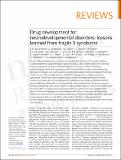| dc.contributor.author | Berry-Kravis, Elizabeth M. | |
| dc.contributor.author | Lindemann, Lothar | |
| dc.contributor.author | Jønch, Aia E. | |
| dc.contributor.author | Apostol, George | |
| dc.contributor.author | Bear, Mark | |
| dc.contributor.author | Carpenter, Randall L | |
| dc.contributor.author | Crawley, Jacqueline N. | |
| dc.contributor.author | Curie, Aurore | |
| dc.contributor.author | Des Portes, Vincent | |
| dc.contributor.author | Hossain, Farah | |
| dc.contributor.author | Gasparini, Fabrizio | |
| dc.contributor.author | Gomez-Mancilla, Baltazar | |
| dc.contributor.author | Hessl, David | |
| dc.contributor.author | Loth, Eva | |
| dc.contributor.author | Scharf, Sebastian H. | |
| dc.contributor.author | Wang, Paul P. | |
| dc.contributor.author | Von Raison, Florian | |
| dc.contributor.author | Hagerman, Randi | |
| dc.contributor.author | Spooren, Will | |
| dc.contributor.author | Jacquemont, Sébastien | |
| dc.date.accessioned | 2020-07-30T00:59:50Z | |
| dc.date.available | 2020-07-30T00:59:50Z | |
| dc.date.issued | 2017-12 | |
| dc.identifier.issn | 1474-1776 | |
| dc.identifier.issn | 1474-1784 | |
| dc.identifier.uri | https://hdl.handle.net/1721.1/126440 | |
| dc.description.abstract | Neurodevelopmental disorders such as fragile X syndrome (FXS) result in lifelong cognitive and behavioural deficits and represent a major public health burden. FXS is the most frequent monogenic form of intellectual disability and autism, and the underlying pathophysiology linked to its causal gene, FMR1, has been the focus of intense research. Key alterations in synaptic function thought to underlie this neurodevelopmental disorder have been characterized and rescued in animal models of FXS using genetic and pharmacological approaches. These robust preclinical findings have led to the implementation of the most comprehensive drug development programme undertaken thus far for a genetically defined neurodevelopmental disorder, including phase IIb trials of metabotropic glutamate receptor 5 (mGluR5) antagonists and a phase III trial of a GABA B receptor agonist. However, none of the trials has been able to unambiguously demonstrate efficacy, and they have also highlighted the extent of the knowledge gaps in drug development for FXS and other neurodevelopmental disorders. In this Review, we examine potential issues in the previous studies and future directions for preclinical and clinical trials. FXS is at the forefront of efforts to develop drugs for neurodevelopmental disorders, and lessons learned in the process will also be important for such disorders. | en_US |
| dc.language.iso | en | |
| dc.publisher | Springer Science and Business Media LLC | en_US |
| dc.relation.isversionof | http://dx.doi.org/10.1038/nrd.2017.221 | en_US |
| dc.rights | Creative Commons Attribution-Noncommercial-Share Alike | en_US |
| dc.rights.uri | http://creativecommons.org/licenses/by-nc-sa/4.0/ | en_US |
| dc.source | Other repository | en_US |
| dc.title | Drug development for neurodevelopmental disorders: lessons learned from fragile X syndrome | en_US |
| dc.type | Article | en_US |
| dc.identifier.citation | Berry-Kravis, E. M. "Drug development for neurodevelopmental disorders: lessons learned from fragile X syndrome." Nature Reviews Drug Discovery 17, 4 (December 2017): 280–299 © 2018 Macmillan Publishers Limited, part of Springer Nature | en_US |
| dc.contributor.department | Picower Institute for Learning and Memory | en_US |
| dc.relation.journal | Nature Reviews Drug Discovery | en_US |
| dc.eprint.version | Author's final manuscript | en_US |
| dc.type.uri | http://purl.org/eprint/type/JournalArticle | en_US |
| eprint.status | http://purl.org/eprint/status/PeerReviewed | en_US |
| dc.date.updated | 2019-09-27T18:14:03Z | |
| dspace.date.submission | 2019-09-27T18:14:04Z | |
| mit.journal.volume | 17 | en_US |
| mit.journal.issue | 4 | en_US |
| mit.metadata.status | Complete | |
